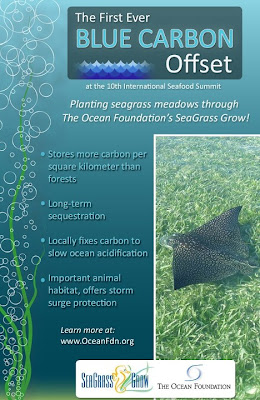During her speech at the Eye on Earth Summit in Abu Dhabi, December 2011, Dr. Silvia Earle highlighted the importance of blue carbon ecosystems -
Dr. Silvia Earle at the Eye on Earth Summit at the Abu Dhabi (photo: Mission Blue).
_____________________________
Dr. Earle Speaks at 'Eye on
Earth Summit'
Thursday, December 15, 2011 / Abu Dhabi / Courtesy of 'The National' / Edited by Deb
Castellana
In 1991, the renowned oceanographer Dr. Sylvia
Earle was in the Gulf to view first-hand the damage being caused by the blazing
oilfields of Kuwait, set alight by retreating Iraqi forces. Now, 20 years later, Dr Earle
is back in the region to warn of other threats to the Gulf's waters, and those
of the world.
She first came to the Gulf
as a chief scientist for the National Oceanic and Atmospheric Administration in
the US, and spent a month scuba diving in the waters of the
Gulf in 1992 as part of an international scientific expedition to survey the
coastline from Oman to Kuwait.
"It was an opportunity
to see the Gulf before all this," Dr. Earle said jokingly yesterday,
pointing to the new high-rises of Abu Dhabi.
After her speech at the Eye
on Earth Summit at the Abu Dhabi National Exhibition Centre, she listed the
threats to the oceans: overfishing, pollution, plastic debris, fertiliser
run-off and other types of chemical waste.
"But the number one
problem, absolutely and by far away, is ignorance," Dr. Earle said.
"You cannot care if you do not know.
Most see the ocean as a
source of food and recreation, but she said recent scientific discoveries had
shown the sea serves a much more profound role in maintaining life on Earth.
"The blue ocean beyond,
the high seas and most of the surface waters on the world … this is truly the
blue engine that is driving the way the world works," Dr. Earle said.
Twenty per cent of the
oxygen in the atmosphere is created by micro-organisms bacteria living in sea
water that were not even known to science before 1986, she said in her speech.
"We don't even
appreciate how much oxygen comes from the sea, but with every breath you take
you are connected to the ocean, no matter where on the planet you live,"
Dr. Earle said.
As the ocean creates oxygen,
it takes in carbon dioxide. This is becoming increasingly important considering
that emissions of the gas are rising as a result of fossil fuels. These
emissions threaten to disrupt the climate with catastrophic consequences.
Algae and coral reefs all
sequester carbon, as do salt marshes and sea grass beds.
Mangroves, the world's only
tree species capable of surviving in salt water, also play an important and
until recently undervalued role.
"Here as well as in
coastal systems all over the world, these systems have been degraded at a rate
even greater than the loss of forests on the land, and yet mangroves are now
known to gather and sequester up to 50 times as much carbon as their
terrestrial counterparts," Dr. Earle said.
"The decisions that we
make in the next 10 years are likely to be the most important in the next
10,000 years because we're right at the edge now, we know, of losing much that
we … could and did, and to some extent still do, take very much for
granted."
Among the speakers at the
environmental event in the Abu Dhabi National Exhibition Centre, which
concludes today, was Dr. Thabit Al Abdessalaam, the director of the marine
biodiversity management sector at the Environment Agency - Abu Dhabi (Ead).
He expressed a similar
opinion.
"We are spending
billions of dollars to capture carbon dioxide and here we have a more natural,
a more effective and cheaper way to share carbon," Dr. Al Abdessalaam
said.
Many steps are necessary to
ensure the preservation of the ocean but ultimately, one key priority is
setting aside more marine-protected areas. For now, just more than 1 per cent
of the ocean is protected, Dr. Earle said.
Dr. Al Abdessalaam said Ead
was considering expanding the territory of protected areas, as well as other
measures to protect important coastal and marine habitats.
A main challenge in Abu Dhabi is "unplanned development projects with the
associated dredging and land reclamation", he said. "We have a window
of 10 years or so to protect what is still there."
_____________________________
- Posted by Sven Stadtmann, GRID-Arendal









